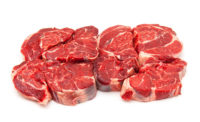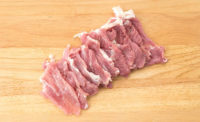Previous research has shown U.S. consumers prefer the flavor of domestic beef over that of Australian (AUS) grass-fed beef or Canadian grain-fed beef, which uses similar grains as Australia. Our study’s objective was to assess the consumer (n = 360) palatability and satisfaction of enhanced and non-enhanced Australian (AUS) grain-fed, AUS grass-fed, and U.S. grain-fed beef from two beef muscles.
Strip loin and top sirloin butt subprimals were collected from 12 AUS grass-fed, 12 AUS grain-fed, and 12 U.S. grain-fed (USDA Choice) carcasses. In addition, tenderloin (psoas major) and eye of round (semitendinosus) subprimals were collected from the same U.S. carcasses to serve as anchors for high and low palatability. All subprimals were wet aged until 29 to 32 days postmortem. The longissimus lumborum (LL) from strip loin subprimals was divided into halves (anterior/posterior) and one half was retained as a block for enhancement. The gluteus medius (GM) was removed from the top sirloin butt subprimal and further separated along the seam into two portions. A controlled balance of the larger “heart” sections from either the left or right sides of each carcass was retained as a block for enhancement. The blocks allocated to enhancement were weighed then enhanced with a solution (see Table 1 for composition) to achieve a 7 percent pump level (GM: 6.9 ± 1.4%; LL: 6.9 ± 1.6%) using a multi-needle pickle injector. Samples were cut into 2.5-centimeter steaks, vacuum packaged and stored frozen until analysis. Steaks were thawed and cooked on a clamshell grill targeting a medium degree of doneness per MSA grill cooking protocols. Consumers (untrained panelists) scored palatability traits including tenderness, juiciness, flavor liking and overall liking on 100-millimeter line scales verbally anchored at 0 (not tender, not juicy, dislike extremely) and 100 (very tender, very juicy, like extremely). Satisfaction was also scored as follows: 2 for unsatisfactory; 3 for good everyday quality; 4 for better than everyday quality; 5 for premium quality. Data were analyzed initially as a randomized complete design and subsequently as a split-split plot design, with the main effects of country of origin/diet (AUS grain-fed, AUS grass-fed and U.S. grain-fed), muscle (LL and GM), enhancement (0 or 7 percent), and all potential interactions as fixed effects.
Enhancement significantly improved palatability in both LL and GM steaks as evidenced by greater (P < 0.05) consumer ratings for tenderness, juiciness, flavor liking, overall liking and satisfaction. Enhancing LL steaks resulted in consumer responses that were comparable or superior to consumer responses for psoas major samples. Similarly, enhancing GM steaks resulted in consumer responses that were comparable or superior to non-enhanced LL samples. Consumers reacted least favorably to non-enhanced AUS grass-fed beef as they rated tenderness, flavor liking and overall liking lowest (P < 0.05) for both LL and GM samples. However, enhancing grass-fed beef resulted in consumer responses that were similar (P > 0.05) to non-enhanced grain-fed beef. This response to enhancement was observed in consumer scores for both LL and GM samples. Consumers could not detect differences (P > 0.05) in tenderness, juiciness, flavor liking or satisfaction between grain-fed beef from Australia and the U.S.
Enhancement of grass-fed GM improved eating quality so it was typically comparable to non-enhanced grain-fed GM; however, consumers scored flavor and overall liking of enhanced grass-fed GM lower compared to enhanced grain-fed GM. Enhancement of grass-fed LL improved eating quality so it was comparable and often superior to non-enhanced grain-fed LL. Consumers even had trouble distinguishing enhanced grass-fed LL from enhanced grain-fed LL, which suggests enhancement can equalize grass-fed LL so that eating quality traits are similar to those of grain-fed LL with or without enhancement.
| Treatment | Tenderness | Juiciness | Flavor Liking | Overall Liking |
| Country of Origin | ||||
| Australian Grain | 69.0a | 67.2 | 66.8a | 66.3b |
| Australian Grass | 62.0b | 64.8 | 60.7b | 58.5c |
| U.S. Grain (USDA Choice) | 69.5a | 68.6 | 68.4a | 71.0a |
| SEM | 1.4 | 1.3 | 1.0 | 1.6 |
| P-value | < 0.01 | 0.09 | < 0.01 | < 0.01 |
| Enhancement x Muscle1 | ||||
| LL – Control | 66.5y,A | 66.1b | 61.3c | 62.5b |
| LL – Enhanced | 79.5x,A | 79.0a | 74.5a | 76.0a |
| GM – Control | 56.4y,B | 57.4c | 58.4c | 57.6c |
| GM – Enhanced | 65.1x,B | 64.9b | 66.9b | 65.1b |
| SEM | 1.6 | 1.5 | 1.2 | 1.2 |
| P-value | 0.14 | 0.05 | 0.04 | 0.01 |
LL — longissimus lumborum samples
GM — gluteus medius samples
a-c Within a column in the upper treatment section, least square means without a common superscript differ (P < 0.05) due to country of origin/diet.
a-d Within a column in the lower treatment section, least square means without a common superscript differ (P < 0.05) due to the enhancement x muscle interaction.
xy Within a column in the lower treatment section, least square means without a common superscript differ (P < 0.05) due to enhancement.
AB Within a column in the lower treatment section, least square means without a common superscript differ (P < 0.05) due to muscle.
1 Control = no enhancement; Enhanced = enhanced with 7% (±1.5%) BAFOSTM beef steak blend consisting of sodium phosphates, hydrolyzed beef protein, salt, sodium bicarbonate, beef flavor (autolyzed yeast extract, beef flavor, beef extract, salt, beef stock).
To read the full research article in “Meat & Muscle Biology,” visit https://www.iastatedigitalpress.com/mmb/article/id/9478/.



Report Abusive Comment